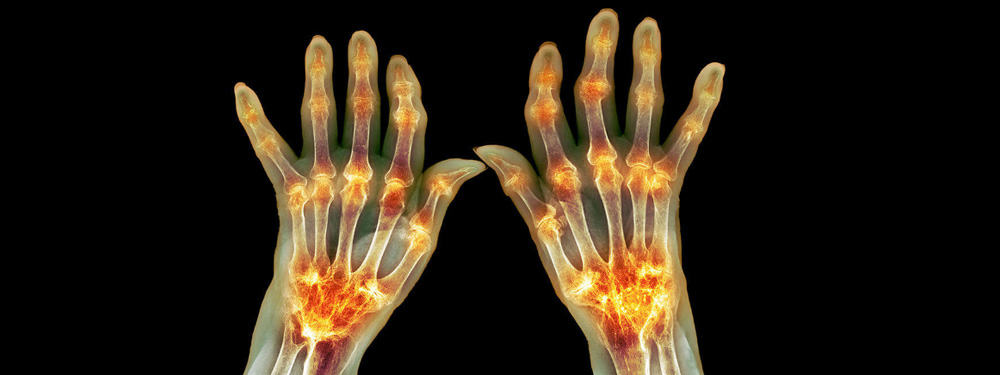Autoimmune arthritis refers to a group of several different types of arthritis whereby your immune system mistakenly attacks your normal healthy joints. Your immune system normally should be defending you against infections and foreign invaders, but it can become dysfunctional and overactive and mistakenly attack your own body. In the case of autoimmune arthritis, the joints are targeted leading to pain, swelling, decreased range of motion, and if left untreated, permanent joint damage and destruction. The most common types of autoimmune arthritis are:
Autoimmune Arthritis

Rheumatoid Arthritis
Rheumatoid arthritis (RA) is the most common type of autoimmune arthritis. RA most commonly causes pain and swelling in symmetrical small joints of the hands, fingers, wrists, feet and ankles. Patients commonly have stiff joints in the morning and can have generalized fatigue. Uncommonly, RA can cause lung fibrosis and rarely, vasculitis. The goal of treatment in RA is to get patients in remission without pain and swelling, improved range of motion and quality of life and reduce or prevent permanent joint damage.
Psoriatic Arthritis
Psoriatic arthritis (PsA) typically occurs in patients who have skin psoriasis, but it can also occur in patients who don’t have any former presentation of psoriasis. PsA can be mild with just occasional flare ups in a few joints, or it can be a chronic arthritis affecting multiple joints. PsA can affect any joint but more commonly affect larger joints in lower extremities but can also show up in the distal fingers, toes, back or sacroiliac joints of the pelvis. Treatment in PsA is tailored to how mild or severe the condition is affecting the patients’ quality of life and prevention of permanent joint damage.
Spondyloarthritis
Spondyloarthritis (SpA) is an umbrella term for autoimmune arthritis that is associated with the HLA-B27 gene, and a unique feature called enthesitis which refers to inflammation of the sites where ligaments and tendons attach to bones. In addition to peripheral involvement (joints of the hands and feet), there can also be axial involvement (spine and sacroiliac joint of the pelvis). SpA can also involve extra-articular manifestations such as iritis or uveitis (inflammation of the eye), psoriasis and pyoderma gangrenosum (skin involvement), and Crohn’s disease and ulcerative colitis (inflammatory bowel disease). Psoriatic arthritis, ankylosing spondylitis, reactive arthritis, IBD-associated arthritis are classified in this family. When a patient has some features of SpA, clearly does not have RA, but cannot be obviously classified in one of those distinct diagnoses, we describe them as undifferentiated SpA.
Ankylosing Spondylitis
Ankylosing spondylitis (AS) causes the spine and sacroiliac joints of the pelvis to fuse and become less flexible which leads to pain and reduced range of motion. It most commonly starts in the teens and early 20s, classically in a young white man but has been found to be under-recognized in women. The major gene associated with AS is called HLA-B27. There is a higher frequency of this gene in the Northern European population. However, having this gene does not automatically make you have this condition. In addition to medications, physical therapy exercises are important in managing symptoms and preventing progression of AS.
Reactive Arthritis
Usually the result of an infection in a different part of the body, reactive arthritis causes joint pain and swelling, most commonly in the knees, ankles and feet. The symptoms of reactive arthritis typically occur days to weeks after the initial infection itself. Classically these bacteria are in the genitals (Chlamydia trachomatis) or the bowel (Campylobacter, Salmonella, Shigella and Yersinia). Reactive arthritis can have a variable course, in some it resolves within six months of the infection, or it can be a relapsing-remitting arthritis, and in others it can evolve into a chronic arthritis requiring long-term treatment to prevent permanent joint damage.
SAPHO Syndrome
SAPHO syndrome (acronym for Synovitis, Acne, Pustulosis, Hyperostosis and Osteitis) is considered to be a rare disorder, though its actual occurrence is probably underreported. The age of onset of symptoms ranges from adolescence to late adulthood, though is most typical among individuals thirty to forty years old. SAPHO syndrome encompasses a wide spectrum manifestations, though often causes bone and skin issues of varying degrees of severity. The onset of bone and joint pain, stiffness and swelling tends to develop slowly over time and may not be recognized at first.
How does Lomibao Rheumatology & Wellness Care treat Autoimmune Arthritis?
Treatment is based on current evidence-based guidelines and is customized to the severity of disease as well as patient preference. Initial fast-acting treatments are typically oral or injection corticosteroids such as prednisone or NSAIDs (non-steroidal anti-inflammatory drugs). DMARDs (disease modifying anti-rheumatic drugs) and Biologics are used as ‘steroid sparing agents’ and are more specific and targeted treatment for the disease. The goal is to reduce pain and swelling, improve range of motion and quality of life, and prevent disease progression observed by joint space narrowing and erosions. Depending on the patient’s needs, sometimes DMARDs and Biologics may be combined. Common DMARDs used for treating autoimmune arthritis include hydroxychloroquine, sulfasalazine, and methotrexate. Infusion biologics offered by Lomibao Rheumatology & Wellness Care for treatment of autoimmune arthritis are Remicade, Simponi Aria, Actemra, Orencia, Rituxan. An injectable treatment offered is Stelara. Wellness services for autoimmune arthritis – coming soon!











